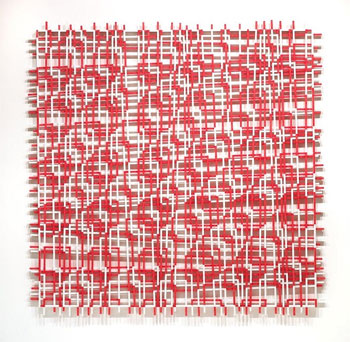Hilarie Mais

Curated by Blair French and Manya Sellers
"The work does not shout or demand, it reveals itself slowly," Hilarie Mais, 2016.
UK-born, Sydney-based artist Hilarie Mais' first major solo exhibition in over a decade will visit TarraWarra Museum of Art, 24 February – 29 April 2018.
The exhibition of 20 works over the last decade is the result of a close collaboration between Mais and the exhibition curators, Blair French (MCA Director, Curatorial and Digital) and Manya Sellers (MCA Assistant Curator).
Since the early 1970s, Mais has consistently produced work underpinned by what she describes as her abiding interest in the history of abstraction, first in the United Kingdom, then the United States, and in Australia since 1981.
Mais is best known for her constructions and paintings that merge the formal structure of the grid with an interest in organic forms found in nature. These patterns and sequences are often drawn from the growth of biological forms. Beginning with a geometric pattern the work then develops instinctually, with Mais incorporating a highly personalised application of paint. Resulting works appear to shimmer optically, drawing the viewer's eyes back and forth through their cycles of line and colour.
Despite the systematic quality of the work, Hilarie Mais notes, "The outcome cannot be predetermined; it evolves, it can be a surprise."
MCA Director, Curatorial and Digital, Blair French said, "Hilarie Mais further establishes MCA's commitment to supporting Australian and international artists at all stages of their careers. It is a privilege to work with Mais, whose practice is of great maturity, evidenced in part by the trust in simple materials, forms and processes, and by the way a particular form can be returned to over and over again, producing new meaning."
Three key threads of the artist's practice can be seen in the exhibition. The first includes work where a 'ghosting' of colour appears to be formed between the work and the wall, drawing the eye beyond the material form and structure of the work to the perceptual field it creates around itself. The second approach is represented in the ongoing Tempus series of paintings, in which Mais returns over and over again to the basic relationship between the grid/square and circle/spiral systems as an underlying structure for making painted wall-based constructions. The third is represented in a multiple component work, Nomad (2006–12), produced as a colour spectrum – another system used within the history of abstract art – based upon waste plastics collected by Mais over a number of years.
TarraWarra Museum of Art Director, Victoria Lynn, said the merging of formal geometric grids and the handmade structure in Mais' work give rise to endless expressive possibilities.
"The apparent formality of her works is underpinned by an intimate sensibility, while the handmade quality evokes a personality which has been referred to as 'feminising' abstraction," Ms Lynn said.
The exhibition is accompanied by a richly illustrated publication covering the whole of Mais' career, presenting and discussing some of her very first artworks through to new work produced for this exhibition. It includes an extensive overview essay, written by Victoria Lynn, along with an artist interview and a number of focus texts on selected bodies of work by several authors including the curators Blair French and Manya Sellers.
Also, at TarraWarra Museum of Art, a concurrent exhibition titled Modern Currents, curated by Victoria Lynn, features works from the Museum's collection of abstract painting and sculpture, providing further context for the exploration of form, colour, line and system.
MORE
- Hyundai A-League Finals Series 2018,...
- Sing for Your Supper at California Burgers and...
- Rave Ride Challenge and Cycling Safety in...
- Tastes of East Village
- The Irish Film Festival
- ArtPlay Fun for School Holidays
- Krispy Kreme and The Simpsons Unite to Create...
- Blak Markets back at Bare Island
- Melbourne Happy Hike with Di Westaway
- NGV Teens Art Party





